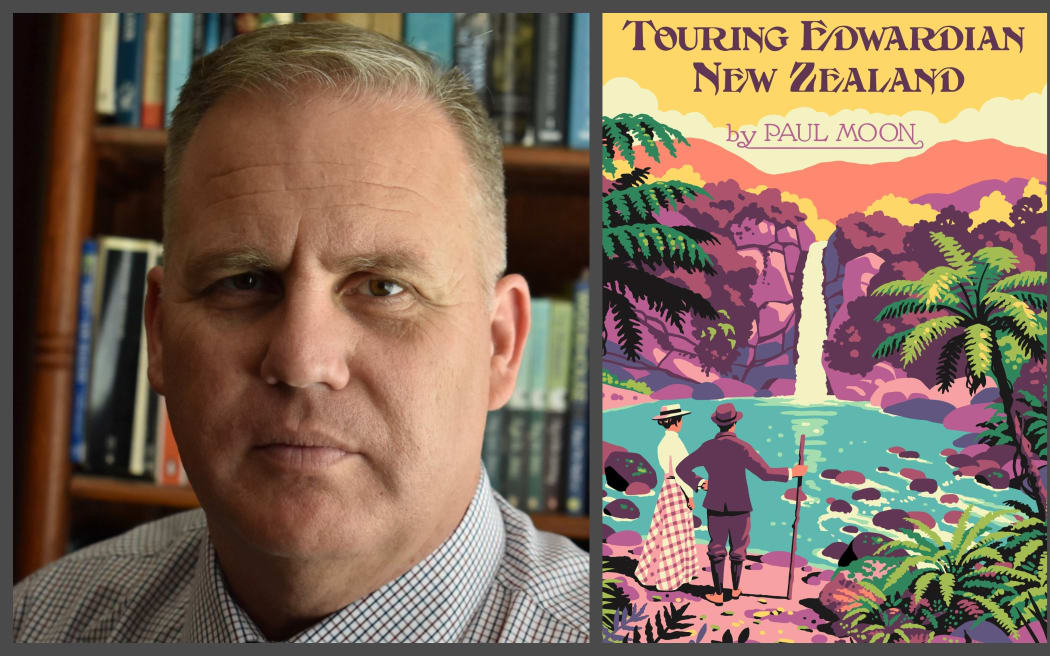What would make a tourist want to spend six weeks on a steamer to get to New Zealand?
That’s how long would-be travellers in the early 20th century invested to get here, plus many more weeks to tour the country and then return home.
Historian Paul Moon takes us back in time with his latest book, Touring Edwardian New Zealand, to look at how the country was advertised to mainly British tourists a time when New Zealand was still dealing with racial tensions and wrestling with its colonial ties to Britain.

Photo: supplied
At the time, Europe was an all too familiar destination for well-travelled tourists and New Zealand’s novelty drew them in, Moon says.
“You would think the Southern Alps would be a huge drawcard except a lot of these visitors had already travelled to Switzerland, or Austria, France or Germany and they’d seen alpine regions.”
The biggest attractions in Aotearoa were places where people could withdraw into the quiet wilderness, he says.
“Auckland was an attraction because it’s a colonial city, it had about I think it was 50,000 people in it at the time … still it’s developed, and yet right on it’s on doorstep, and the Thomas Cook guide was very emphatic about this, you can step into this primordial forest of a sort that doesn’t exist anywhere else in the Western world.
“Auckland was sold then and is still sold now as a place where you can go from the bustling city, out into the very old forest in a matter of 20 minutes and that was a novelty for tourists then.”
Thomas Cook was one of the most successful travel agencies in the country, he says.
“The reason that they became successful is that they offered everything.
“But they’re controlling every stage of your journey and they’re basically collecting money from you at every stage of your journey.
“So it was very sophisticated business model which gave the illusion of choice that tourists could go wherever they wanted to. In fact, parts of the country were locked off to them if you went on one of these tours.”
There were few attractions, as far as Thomas Cook was concerned, in Wellington at the time, he says.
“Wellington was identified as really the culture capital of New Zealand, if you wanted to see an opera or a show, Wellington was the place on your journey to see it.
“But apart from that, there wasn’t much in the way of attractions, and it was one of those stop-off points before you headed off to the South Island.”
Instead, places like Christchurch and Dunedin took top honours of cities to visit, he says.
“It’s got that sense of the old world about it, and so it’s a nostalgic wander through what you imagine the ideal British city might have been like a generation or two earlier.
“So people were coming to New Zealand to see things that were different but also to capture nostalgic view of a bucolic country, of the way they imagined England might’ve been perhaps in the time of Constable, that sort of rosy cheeked children running through farms and that type of thing, New Zealand delivered that in bucketloads.”
While in the Victorian era there was some display of Māori culture, albeit contrived, it was basically invisible in the Edwardian era to visitors, Moon says.
“The belief was in this period, particularly in the early Edwardian period, that the Māori population was about to disappear.
“So if you arrived in Auckland just before World War One, there’d be a plaque on One Tree Hill, you’d see that this is a monument to the dying race.
“So when it comes to indigenous culture, the best you get offered as far as tourists are concerned in this period, is a visit to the museum and that’s hugely disappointing as you can imagine but it reflects in a way prevailing attitudes about the disappearance of this group.”
There was also a lot of money made out of bogus health claims, he says.
“Some of the greatest doctors allegedly in the world said that if you soaked in a health spa in a mineral pool somewhere north of Auckland, you’d cure arthritis, gout, psoriasis, eczema and just about everything else.
“But of course, that faded by the 1920s and it was seen to be what it was, which is sham health [claims].”
Travel agencies, often foreign companies, would end up taking commissions from anywhere they could, he says.
“What you’re left with is operators here, who survive on the crumbs.
“And the profit that was being made was by this big tour firms that funnelled a reasonable volume of tourists through your business but they did so because you had to agree to accept those tourists for a very low fee.
“That’s changed now, there’s a number of medium sized operators in the country – pre-Covid – that actually made good profits because they cut out that middle person.”

